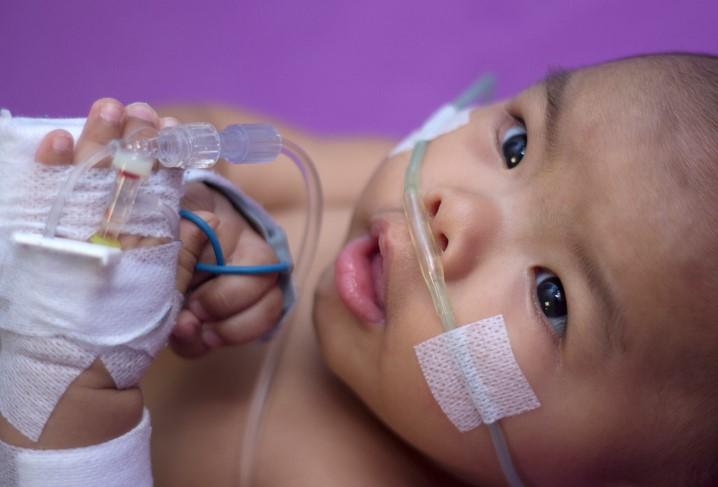A new analysis of seasonal flu deaths in US children in the six seasons that followed the 2009 H1N1 pandemic reveals that children ages 2 and younger are most at risk, and of children who died, less than a third had been vaccinated against the disease.
Young children's vulnerability to flu and the gap in vaccination takes on extra significance this flu season, which has already recorded 63 pediatric flu deaths, shows no sign of a peak yet despite an early start, and has reached the flulike illness levels seen during the 2009-2010 pandemic.
The new study, done by researchers at the US Centers for Disease Control and Prevention, appeared yesterday in an early online edition of Pediatrics.
Threats to youngest, even healthy children
Flu deaths in children have been nationally notifiable since 2004, which has allowed the CDC to begin keeping more detailed records. Since then, reported numbers have ranged from 37 in the 2011-2012 season to 358 during the H1N1 pandemic season. The CDC has had a universal flu vaccine recommendation in place for those ages 6 months and older since 2010, and last season the highest vaccination coverage, at 76.3%, was in children ages 6 to 23 months.
To look more closely at the latest fatality patterns, the team examined lab-confirmed pediatric flu deaths for six flu seasons between 2010-2011 to 2015-2016.
During that time, 675 deaths were reported in children younger than 18, with an average of 113 deaths per year. Levels were highest in babies younger than 6 months old, followed by kids ages 6 to 23 months old.
Only 31% of children age 6 months and older who died had been vaccinated against flu.
Data reveal flu as a quick killer, treatment gaps
When researchers looked at clinical patterns, they found that in children, flu can kill quickly. About 65% died within 7 days of symptom onset. And though children with preexisting medical conditions are known to be at higher risk for flu complications, the team found that half were previously healthy.
Healthy youngsters who died from their flu infections were more likely than peers who had underlying medical conditions to be younger, less vaccinated, die before hospital admission, and have shorter illness durations. As other studies found, Streptococcus and Staphylococcus aureus were the most common bacterial coinfections, which were more common in kids who didn't have underlying medical conditions.
More than half of the kids who died received antiviral or antibiotic treatment.
The team said it's not clear why some kids die so quickly from flu, but they said the shorter duration among healthy children might reflect differences in healthcare-seeking behavior or timing of treatment interventions.
As other studies have found, the proportion of influenza B deaths was slightly higher than those from influenza A, and more research is underway to detail the pattern. The team said some have suggested the possibility of slower development of age-related immune response to influenza B.
Researchers said some of the main messages from the study are the need to improve flu vaccination coverage in children and that prompt antiviral treatment should be given, especially in young children, those with underlying illness, and those who hare hospitalized with suspected flu.
Questions, important lessons
In a related commentary in the same issue, Kathryn Edwards, MD, a pediatric infectious disease specialist at Vanderbilt University in Nashville, wrote that the group's characterization of children's flu deaths is nearly identical to findings in a study published more than a decade earlier, which was a somber reminder of the impact of flu on children.
She said one intriguing new finding in the report is that coinfection with respiratory syncytial virus (RSV) were detected in 24 of the kids who died. "Were the children first infected with RSV and then influenza?" Edwards wondered. She also noted that bronchiolitis was diagnosed in 22 deaths.
The findings raise many critical questions, she said, such as what data might help clinicians distinguish between those who die and those who don't, and if there are biomarkers that might help predict disease severity. Edwards wrote that knowledge gaps include finding clues to tell which patients might benefit from immediate antibiotic use, what are the best ones to prescribe, and what are the resistance patterns of bacteria detected.
Edwards said important lessons from the new study are that flu vaccination coverage in children must be improved, as does maternal vaccination, given that only one-third of pregnant women are immunized against flu in the recent season.
Also, she noted that judicious use of antibiotics in patients with coinfections should always be considered and that prompt use of neuraminidase inhibitor antivirals in chronically ill or hospitalized kids should be implemented.
"We can only hope that when the data are published at the end of the next decade, we will see a reduction in fatalities in children with influenza," Edwards said.
See also:
Feb 12 Pediatrics abstract
Feb 12 Pediatrics commentary
Feb 9 CIDRAP News story "Flu-like illness in US reaches 2009 pandemic levels"




















